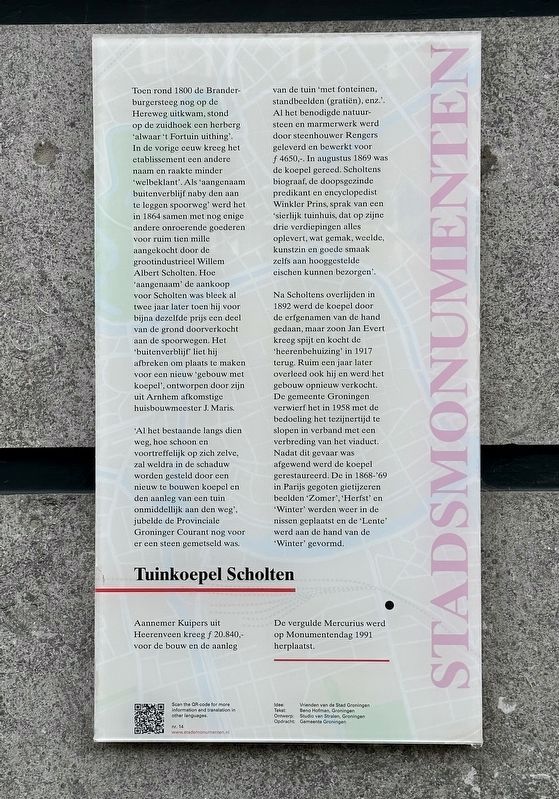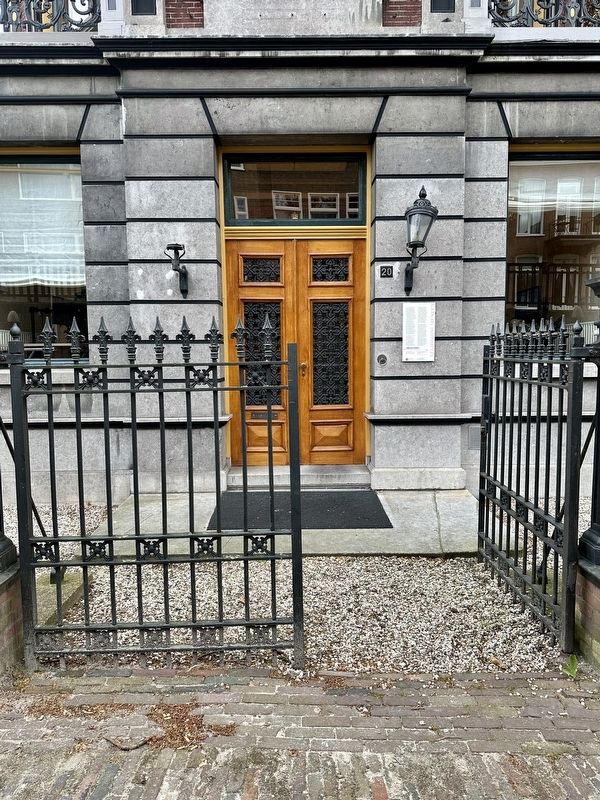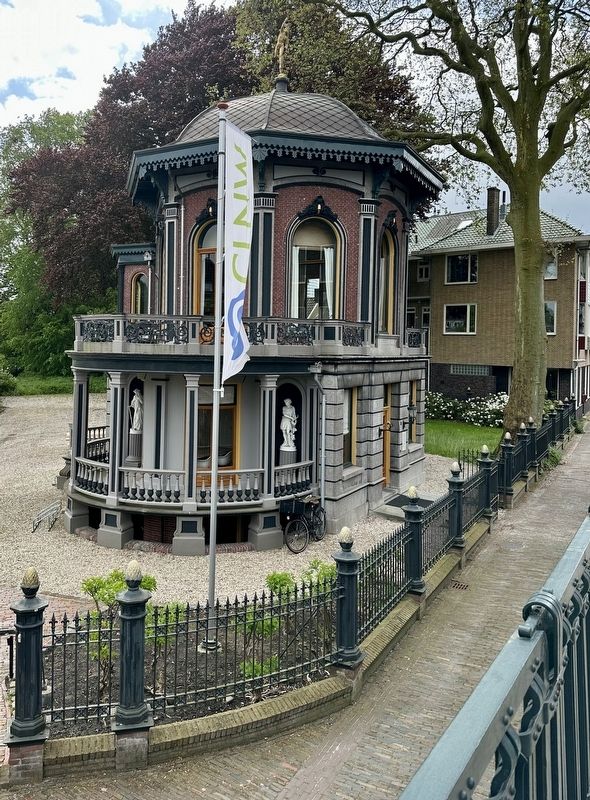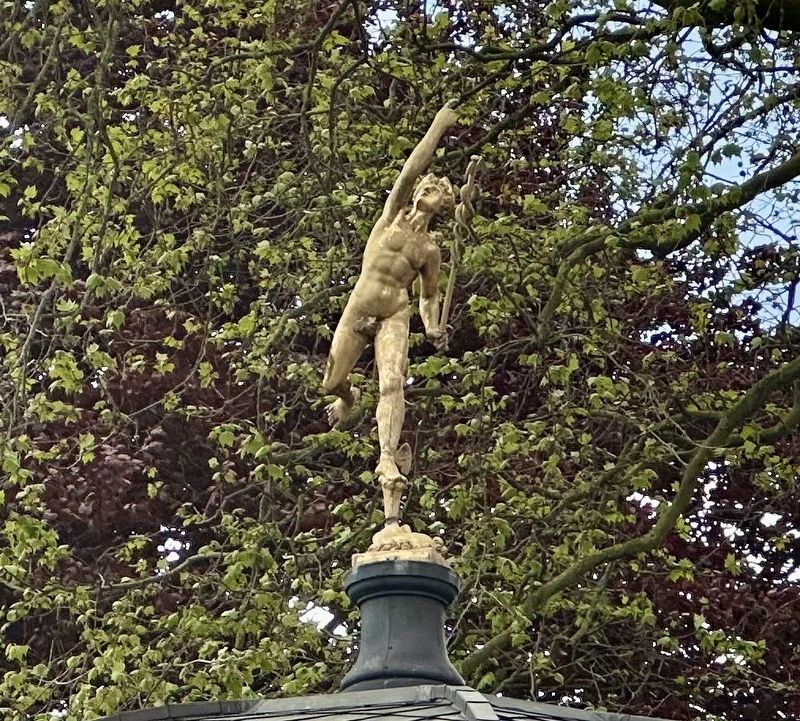Groningen, Netherlands — Northwestern Europe
Tuinkoepel Scholten
— Stadsmonumenten —
‘Al het bestaande langs dien weg, hoe schoon en voortreffelijk op zich zelve, zal weldra in de schaduw worden gesteld door een nieuw te bouwen koepel en den aanleg van een tuin onmiddellijk aan den weg’, jubelde de Provinciale Groninger Courant nog voor er een steen gemetseld was. Aannemer Kuipers uit Heerenveen kreeg ƒ 20.840,- voor de bouw en de aanleg van de tuin ‘met fonteinen, standbeelden (gratiën), enz.’. Al het benodigde natuursteen en marmerwerk werd door steenhouwer Rengers geleverd en bewerkt voor ƒ 4650,-. In augustus 1869 was de koepel gereed. Scholtens biograaf, de doopsgezinde predikant en encyclopedist Winkler Prins, sprak van een ‘sierlijk tuinhuis, dat op zijne drie verdiepingen alles oplevert, wat gemak, weelde, kunstzin en goede smaak zelfs aan hooggestelde eischen kunnen bezorgen’.
Na Scholtens overlijden in 1892 werd de koepel door de erfgenamen van de hand gedaan, maar zoon Jan Evert kreeg spijt en kocht de ‘heerenbehuizing’ in 1917 terug. Ruim een jaar later overleed ook hij en werd het gebouw opnieuw verkocht. De gemeente Groningen verwierf het in 1958 met de bedoeling het te zijner tijd te slopen in verband met een verbreding van het viaduct. Nadat dit gevaar was afgewend werd de koepel gerestaureerd. De in 1868-’69 in Parijs gegoten gietijzeren beelden ‘Zomer’, ‘Herfst’ en ‘Winter’ werden weer in de nissen geplaatst en de ‘Lente’ werd aan de hand van de ‘Winter’ gevormd.
De vergulde Mercurius werd op Monumentendag 1991 herplaatst.
When, around 1800, the Brandenburger alley still led to the Hereweg, there was a hostel which looked very expensive on the south corner. In the previous century, the establishment received another name and got less well-known. As pleasant outside stay close to the railway, it was bought for ten thousand by the great industrial Willem Albert Scholten together with some other real estates in 1864. How ‘pleasant’ the purchase was for Scholten, turned out two years later when he resold a part of his ground to the railways for almost the same price. He demolished the ‘retreat place’ to make room for a new ‘building with a dome’, designed by his master of building houses, J. Maris, coming from Arnhem.
‘All that existed along that way, how clean and excellent on itself, will be excelled by a new dome and the construction of a garden directly on the road’, rejoiced the Provincial Groninger Courant even before a brick was laid. Contractor Kuipers from Heerenveen received 20,840 Guilders for the construction and the construction of the garden ‘with fountains, statues (Charites), etc.’. All the necessary natural stones and marble work was supplied by the stonemason Rengers and processed for 4650 Guilder. In August, 1869, the dome was finished. Scholtens’ biographer, the Baptist parson and encyclopaedist Winkler Prins, spoke of a ‘gracious garden house, which on its three floors paid off everything, how convenient, luxurious, artistic and with a good taste, even able to offer this under high requests.’
After the death of Scholtens in 1892, the dome was sold by the inheritors, but the son Jan Evert regretted this and bought the ‘heerenbehuizing’ back in 1917. An ample year later he also died and the building was sold again. In 1958 the municipality Groningen acquired it with the meaning to demolish it on a certain moment relating to the enlargement of the viaduct. After this danger was averted, the dome was restored. The statues which are poured in Paris in 1868-’69 with cast-iron: ‘Zomer’, ‘Herfst’ and ‘Winter’ were again placed in the bays and the ‘Lente’ was formed next to the ‘Winter’.
The gold-plated Mercury was reinstated on the Monuments Day in 1991.
Erected by Gemeente Groningen. (Marker Number 14.)
Topics and series. This historical marker is listed in this topic list: Notable Buildings. In addition, it is included in the Groningen Stadsmonumenten series list.
Location. 53° 12.624′ N, 6° 34.3′ E. Marker is in Groningen. Marker is on Hereweg, on the left when traveling south. Touch for map. Marker is at or near this postal address: Hereweg 20, Groningen 9725 BS, Netherlands. Touch for directions.
Other nearby markers. At least 8 other markers are within walking distance of this marker. Hereplein 4-5 (approx. 0.4 kilometers away); Heresingel 13 (approx. 0.4 kilometers away); Herestraat 106 (approx. 0.4 kilometers away); St. Jozefkerk / St. Joseph Church (approx. half
a kilometer away); De Toekomst / “The Future” (approx. half a kilometer away); Hoofdstation / Main Railway Station (approx. half a kilometer away); Ged. Zuiderdiep 96-98 (approx. 0.6 kilometers away); Synagogue (approx. 0.6 kilometers away). Touch for a list and map of all markers in Groningen.
Credits. This page was last revised on May 25, 2023. It was originally submitted on May 24, 2023, by Andrew Ruppenstein of Lamorinda, California. This page has been viewed 58 times since then and 14 times this year. Photos: 1, 2, 3, 4. submitted on May 24, 2023, by Andrew Ruppenstein of Lamorinda, California.



